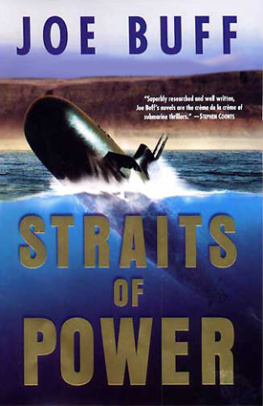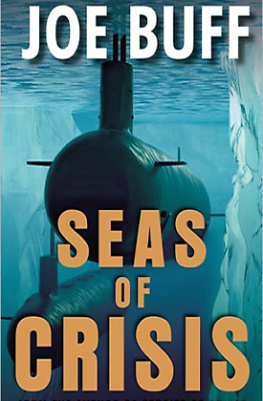JOE BUFF is a life member of the U.s. naval Institute, the naval submarine league, the navy league of the United states, the cec/seabees historical Foundation, and the Fellows of the naval War college. respected for his technical knowledge, he is considered an expert in submarines and national defense. two of his nonfiction articles about future submarine technology have won annual literary awards from the naval submarine league. he is the author of four previous highly regarded novels of submarine warfare Tidal Rip, Crush Depth, Thunder in the Deep , and Deep Sound Channel and lives with his wife in dutchess county, new York. You can visit his website at www.joebuff.com .
Visit www.AuthorTracker.com for exclusive information on your favorite HarperCollins authors.
T o begin, I want to thank my formal manuscript readers: Captain Melville Lyman, U.S. Navy (retired), commanding officer of several SSBN strategic missile submarines, and now director of Special Weapons Safety and Surety at the Johns Hopkins Applied Physics Laboratory; Commander Jonathan Powis, Royal Navy, who was navigator on the fast-attack submarine HMS Conqueror during the Falklands crisis, and who subsequently commanded three different British submarines; retired senior chief Bill Begin, veteran of many boomer deterrent patrols; and Peter Petersen, who served in the German Navys U-518 in World War II. Thanks also go to two navy SEALs, Warrant Officer Bill Pozzi and Commander Jim Ostach, and to Lieutenant Commander Jules Steinhauer, USNR (retired), diesel boat veteran and naval aviation submarine liaison in the early Cold War, for their feedback, support, and friendship.
A number of other navy people gave valuable guidance: George Graveson, Jim Hay, and Ray Woolrich, all retired U.S. Navy captains, former submarine skippers, and active in the Naval Submarine League; Ralph Slane, vice president of the New York Council of the Navy League of the United States, and docent of the Intrepid Museum; Ann Hassinger, research librarian at the U.S. Naval Institute; Richard Rosenblatt, M.D., formerly a medical consultant to the U.S. Navy; Commander Rick Dau, USN (retired), former operations director of the Naval Submarine League; Bill Kreher, current operations director; and retired reserve U.S. Navy Seabee chief Stormin Normand Dupuis.
Additional submariners and military contractors deserve acknowledgment. They are too many to name here, but continuing to stand out vividly in my mind are pivotal conversations with Commander (now Captain) Mike Connor, at the time CO of USS Seawolf, and with the late Captain Ned Beach, USN (retired), brilliant writer and great submariner. I also want to thank, for the guided tours of their fine submarines, the officers and men of USS Alexandria, USS Connecticut, USS Dallas, USS Hartford, USS Memphis, USS Salt Lake City, USS Seawolf, USS Springfield, USS Topeka, and the modern German diesel submarine U-15. I owe deep appreciation to everyone aboard USS Miami, SSN 755, for four wonderful days on and under the sea.
Similar thanks go to the instructors and students of the New London Submarine School, and the Coronado BUD/SEAL training facilities, and to all the people who demonstrated their weapons, equipment, attack vessels, and aircraft at the amphibious warfare bases in Coronado and Norfolk. Appreciation also goes to the men and women of the aircraft carrier USS Constellation, the Aegis guided missile cruiser USS Vella Gulf, the fleet-replenishment oiler USNS Pecos, the deep-submergence rescue vehicle Avalon, and its chartered tender R/V Kellie Chouest.
The Current Strategy Forum and publications of the Naval War College were invaluable. The opportunity to fly out to the amphibious warfare helicopter carrier USS Iwo Jima during New York Citys Fleet Week 2002, and then join her sailors and marines in rendering honors as the ship passed ground zero, the former site of the World Trade Center, was one of the most powerfully emotional experiences of my life.
First among the publishing people deserving acknowledgment is my wife, Sheila Buff, a nonfiction author and coauthor of more than two dozen books on health and wellness, hiking, and nature loving. Then comes my agent, John Talbot, touchstone of seasoned wisdom on the craft and business sides of the writing profession. Equally crucial is my editor at William Morrow, Mike Shohl, always enthusiastic, accessible, and inspiring through his keen insights on how to improve my manuscript drafts.
Australia
HarperCollins Publishers (Australia) Pty. Ltd.
25 Ryde Road (P.O. Box 321)
Pymble, NSW 2073, Australia
www.harpercollins.com.au/ebooks
Canada
HarperCollins Canada
2 Bloor Street East - 20th Floor
Toronto, ON, M4W, 1A8, Canada
http://www.harpercollins.ca
New Zealand
HarperCollins Publishers (New Zealand) Limited
P.O. Box 1
Auckland, New Zealand
http://www.harpercollins.co.nz
United Kingdom
HarperCollins Publishers Ltd.
77-85 Fulham Palace Road
London, W6 8JB, UK
http://www.harpercollins.co.uk
United States
HarperCollins Publishers Inc.
10 East 53rd Street
New York, NY 10022
http://www.harpercollins.com
S TRAITS OF P OWER
T IDAL R IP
C RUSH D EPTH
T HUNDER IN THE D EEP
D EEP S OUND C HANNEL
And coming soon in hardcover
from William Morrow
S EAS OF C RISIS
May 2012
C ommander Jeffrey Fuller stood waiting in the warmth on the concrete tarmac at a small corner of the sprawling U.S. Navy base in Norfolk, Virginia. He looked up at the very blue sky, telling himself that today was a good day for flying: sunny, with almost no haze; easterly breeze at maybe ten knots; and a scattering of high, whispy, bright-white clouds. Noise from helicopters taking off and landing assaulted his ears. Another helo sat on a pad in front of him, as its powerful twin turbine engines idled. The main rotors above the Seahawks fuselage, over the passenger compartment, turned just fast enough to be hypnotic. Jeffrey had been badly overworked for much too long. He fought to not stare at those blades, and abandon himself to being mesmerized, and letting his mind go blank and drift away. But the intoxicating stink of sweet-yet-choking helo exhaust fumes, mixed with the subtler smell of the seashore wafting from the mouth of the Chesapeake Bay, stirred his combat instincts, helping him stay alert and on his toes.
Jeffrey glanced at his watch, then at the cockpit of the matte gray Seahawk. The pilot and copilot sat side by side, running through their checklists. The helo should be ready for boarding soon.
Jeffrey was glad. Ever since hed woken up before dawn this morning, for some reason he felt the loneliness and burdens of command with added poignancy. This seemed a warning of bad things to come, things he knew in his bones would happen soonJeffrey had learned to trust his sixth sense for danger and crisis through unforgiving, unforgettable experience. The ceramic-composite-hulled nuclear submarine of which he was captain, USS Challenger, sat in a heavily defended, covered dry dock at the Northrop Grumman Newport News Shipbuilding yards not far from here, northwest across the James River. For several weeks now shed been laid up and vulnerable, undergoing repairs and systems upgrades after Jeffreys latest hard-fought battle, thousands of miles away, deep under the sea.
His rather young and clean-cut crew were working on Challenger around the clock, side by side with the shipyards gruff and gritty men and women who applied their skills to Jeffreys ship with a vengeance. Vengeance of a different sort was on everyones mind, because this terrible war against the Berlin-Boer Axis was by no stretch of the imagination close to being won. Atomic explosions were devastating the Atlantic Ocean ecosystem, and stale fallout from the small warheads being used sometimes drift to settle in local hot spots even well inland. Gas-mask satchels were mandatory for all persons east of the Mississippi; radiation detectors were everywhere. Some reservoirs, too contaminated, were closed until further notice; entire industries, including East Coast beach resorts, were wiped out, even as other industries thrived because of the war. Only price controls, and price supports, prevented rampant hyperinflation or a regional real estate market crash.
Next page











